Discover the story of people that helped North Perth to become what it is today.
 Nick Catania (1945 - )
Nick Catania (1945 - )
Nick Catania was born in 1945 in the Italian village of Castell’Umberto, Sicily. He migrated to Perth in 1952 with his mother, joining his father who had earlier left post-war Italy in search of a better life. The Catania family lived in East Perth before moving to 485 Fitzgerald Street, North Perth in 1954. The home (‘Vincent House’) remained in the family until 2000.
|

Nick Catania ready for school, aged 7, 1952.
|

Nick Catania and parents at North Perth Town Hall, 1963.
|
In the 1950s and 60s, Nick attended Saint Francis Xavier Catholic primary in East Perth, Christian Brothers College, Highgate and then the University of Western Australia, where he received a Bachelor of Economics degree. He worked in a range of private and public sector jobs before entering Parliament as the Labor member for Balcatta from 1989-1996. After leaving Parliament, he served as the Mayor of Vincent from 2000-2011.
Nick Catania was interviewed in 2003 and shared his rich memories of growing up in North Perth.
"When Beatty Park was being built to house the swimming for the 1962 Commonwealth Games (or Empire Games, as they were called), myself and my mates who I went to school with, we wanted to be the first ones in there. So when we heard the water was being put into Beatty Park… on the second or third night we decided to jump the fence and have a swim in the diving pool which, by the way, wasn’t full. We snuck in, sort of slid into the pool and we were swimming around when one of my friends decided that he wanted to make a bigger splash by climbing onto the tower. There was a three metre tower as well as a diving pool which was, I think, the springboard. So he jumped from the springboard into the pool, made a big splash, and the caretaker came out and chased us. We were lucky to get over the fence because, needless to say, we didn’t have any bathers, and we were sort of grabbing our clothes as we were going over the fence, which at the time had barbed wire…"
Read the full transcript of an interview with Nick Catania.
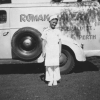 Nicholas Tolcon (1940 - )
Nicholas Tolcon (1940 - )
The Honourable Nicholas Tolcon, former Family Court Judge, was born in January 1940 in the Goldfields town of Norseman to Macedonian migrants, Jury and Elefteria (‘Lilly’) Tolcon. The Tolcon family moved to Perth after WWII and established the Roman Bakery in 1947, initially in partnership with family member Peter Tombidies at 252-4 Fitzgerald Street, later moving to 385-387 Fitzgerald Street in 1949. The business operated on Fitzgerald Street from 1949 to 1979.
During a time of post-war building shortages, Jury and Lily built a bedroom and kitchen at the rear of the bakery, where they lived until they were able to build their own home adjacent to the business at 103 Alma Road, North Perth.
|

The Tolcon family with Nicholas (standing), 1951.
|

Nicholas Tolcon with Roman Bakery delivery van, 1948.
|
As a boy in the 1940s and 50s, Nicholas remembers the long hours and hard work in the family’s bakery business:
“In operating a bakery business meant that my father was away from the early hours of the morning. It also meant that everyone was in bed soon after 7pm. In those days bread was delivered six days a week and the seventh day was to prepare for the Monday. Mum and I were involved and it wasn't very long after this was established that I would help deliver bread after school and most certainly on Saturday mornings. This meant that I missed out on the Friday fellowship at the Rosemount Picture Theatre and missed out on the Friday serial. During winter, particularly during the football season I would be an offsider for one of my uncles, who was a bread carter, who also played football. We would start work at about 2am on a Saturday morning, and I would finish delivering bread somewhere between 7 and 8 am. That would enable me to get to the football for 9, 9.30 or later that morning. My uncle, who played for Perth, continued to work for a few hours after to complete the round and then got to his football match. We did not regard that as a hardship, it was a matter we took in our stride…”
Read the full transcript of an interview with Nicholas Tolcon
Read the full transcript of an interview with Elefteria (‘Lilly’) Tolcon
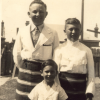 Bill Woodthorpe
Bill Woodthorpe
Before the days of supermarkets, butcher shops were a much more common sight in Perth. In 1950, there were 14 retail butcher shops in North Perth alone. The Woodthorpe family ran several butcher shops in the area from 1910 until the 1970s.
Woodthorpe’s was established by John Patrick (‘Jack’) Woodthorpe at 318 Bulwer Street in 1910, moving to 330 Bulwer Street opposite the Commonwealth Hotel (now the Hyde Park Hotel) in 1912. Grandson Bill Woodthorpe recalls that the original shop “had ice in the basement – just ordinary ice in a big ice chest thing or boxes. That’s all the refrigeration they would have had there.”
|

Woodthorpe children (Bill Woodthorpe in front) dressed as butchers for a school fancy dress, c.1930s.
|

Woodthorpe’s butcher shop, Angove & Fitzgerald Streets c.1920s.
|
Jack Woodthorpe subsequently opened another two shops at 1 Angove Street in 1917 and 365 Fitzgerald Street in 1920. The Woodthorpe’s had a family of five sons and a daughter, most of whom worked in the family business. The family lived at 363 Fitzgerald Street, originally beside the butcher’s shop, and later nearby at 154 Raglan Road. Jack Woodthorpe was a bird lover and his grandson Bill tells the story of the family’s pet cockatoo hitching a ride on the tram up Fitzgerald Street to the butcher shop on the corner of Angove and Fitzgerald.
"They lived in between on the Raglan Road corner. They had a cocky and it used to get on the tram and go to that shop and they’d put it off and come home. The tram driver would be the same old one… It got on in Raglan Road at the house there – Raglan and Fitzgerald. The tram would go and then turn the corner and he’d let him off there (at Angove). Then he’d do the trip home. I think that’s true; I was told that. Oh he’d spend a little while, probably get a bit of meat, chew away and then, ‘I’m off home for a rest’. "
Read the full transcript of an interview with Bill Woodthorpe
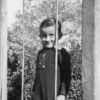 Brian Mouchemore (1946 - )
Brian Mouchemore (1946 - )
Brian was born in 1946 and lived with his family at 29 Richmond Street in the 1940s & 50s. Five generations of the Mouchemore family lived at 29 Richmond Street, dating back to his great grandmother Thursa Clapp in 1920.
|

Mouchemore family portrait, c.1948.
|

Brian Mouchemore on a swing in the backyard of 29 Richmond Street, c.1950s.
|
Brian’s recollections of growing up in the area in the 1940s and 50s are filled with stories and adventures of a free range childhood spent exploring the lakes and drains which characterised the area.
"Smith’s Lake was my primary discovery when I was a little kid. I wandered down the end of the street and found this great area which was the equivalent of an African savanna in my eyes... Through the centre of Smith’s Lake was a drain which we used to get into in summer; sometimes the water would be 18 inches to 2 feet deep and we could swim in there and slide on the slime on the side of the drain. The fabulous drain. It drained into the river at one end and back up to Dog Swamp. It was four foot six inches in diameter and we used to take candles. You’d get a couple of hundred yards up and the oxygen starvation would put the candle out. And when you looked out where you had entered the drain it was all dark and there was this little light right down the end. So you knew the way out. We went down the southern end one day and came to an area where the water from the drain actually flowed into a huge concrete box and there were pipes that went off, so we thought we had better not go any further, otherwise we could have ended up in trouble. And I suspect that was under the intersection of Charles and Vincent Street because we could hear cars going rumbling across the top about 10 feet up."
Read the full transcript of an interview with Brian Mouchemore
 Giuseppina Merlo (1935 - )
Giuseppina Merlo (1935 - )
Giuseppina Merlo (nee Condelli) was born in 1935 in the Italian village of Gerace, Calabria. In 1956, she migrated with her sister to Perth, joining her father who had migrated earlier and was living with relatives at 72 Angove Street. Giuseppina and her family were among the many migrants from Italy and Southern Europe who came to call North Perth home in the post-war period.
Giuseppina married Vincenzo Merlo in 1958 and had four children. From 1962, the family lived at 9 Glebe Street, North Perth. In 1972, the family demolished the original house and lived in sheds and converted garages while a new house was built from the recycled bricks, which the children cleaned for pocket money.
|

Giuseppina Merlo and family in Glebe Street North Perth, 1962.
|
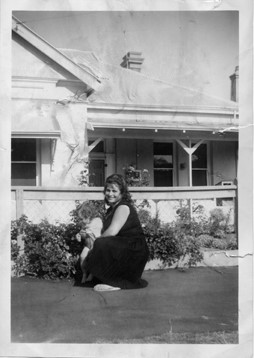
Giuseppina Merlo at home in Glebe Street, North Perth 1962.
|
Giuseppina worked as a seamstress for the Sekem Knitting Factory (Superior Knitting Mills) in Carnation Street (now Sekem Street) North Perth. The factory was established in 1923 and operated in North Perth until the 1960s with a workforce that included many local migrant women like Giuseppina.
“[The Manager] she come to me and say, ‘Giuseppina you think you can learn to use the machine?’ I say, ‘Give me one hour, hour-and-a-half.’ I did it in one hour-and-a-half. I learn it straight away. And she kept me there to work on that machine. I worked on the lock sewing machine, the machine to put buttons on, the machine to put the bone, the machine to put the collar. They had a lot of machines there. And my Italian friends were jealous. They say, ‘I work here for a long time and they leave me on the table, just to iron and they put you on the machine.’ I say, ‘Because I learnt to use the machine quickly’. So I was happy.”
Read the full transcript of an interview with Giuseppina Merlo and son Ralf Merlo
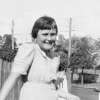 Paula McAdam (1934 - 2017)
Paula McAdam (1934 - 2017)
Paula McAdam was born at 98 Angove Street, North Perth in 1934 to parents Frank & Kathleen McAdam. She was the youngest of the McAdam family who lived on Angove Street, North Perth from 1923 to the 1970s. Major Frances Joseph McAdam was a WWI veteran who recorded his experience of the Gallipoli landing in a diary and letters.
The McAdam family story reflects the impacts of WWI on the local community and also the importance of institutions such as Saint Brigid’s Church and the Redemptorist Monastery for local Catholic families.
|

Paula McAdam with bike outside 98 Angove Street, North Perth 1945.
|
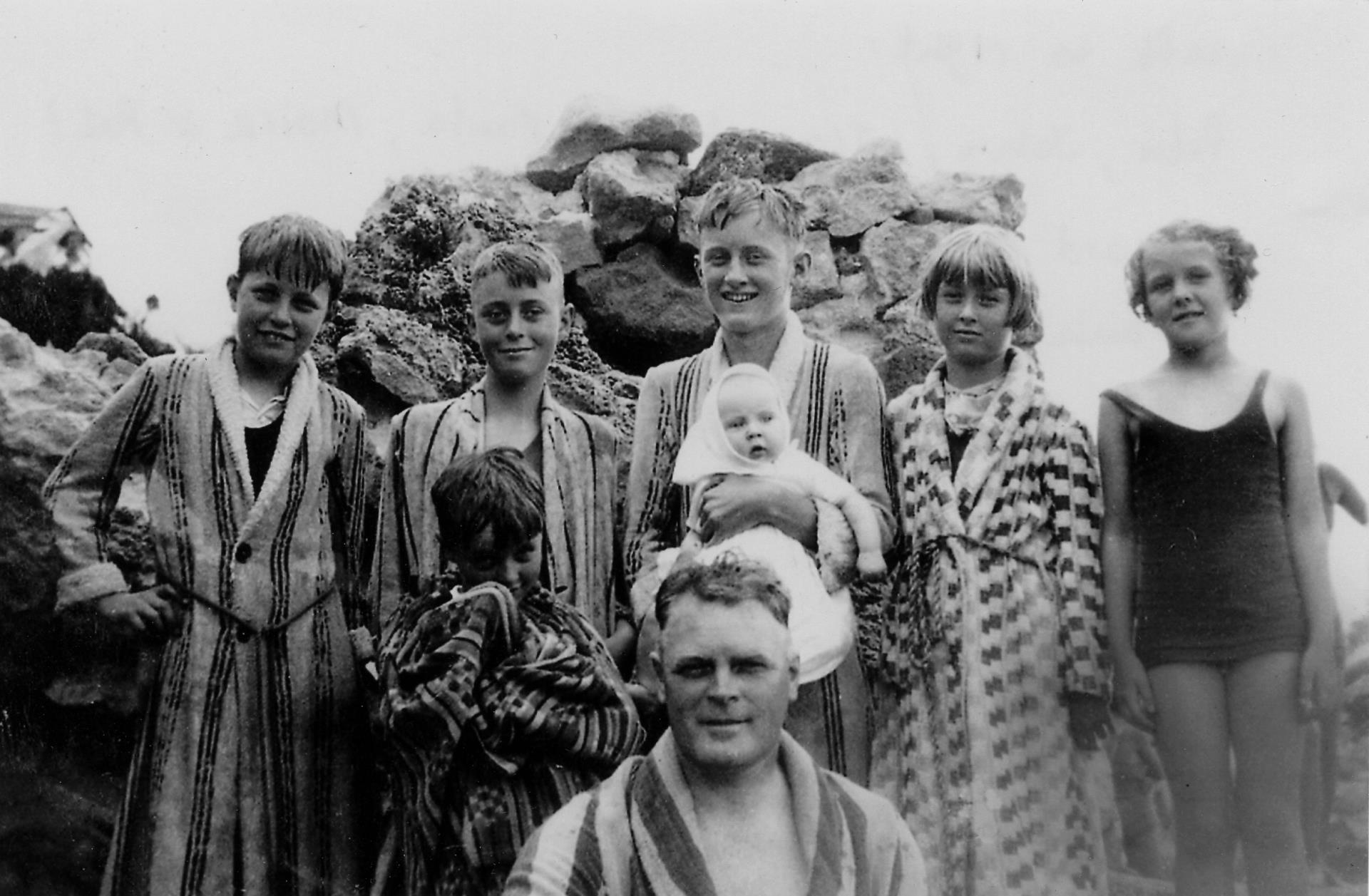
The McAdam family of North Perth (with baby Paula centre) at North Beach, 1935.
|
Kathleen and Frank McAdam met at Saint Brigid’s and sang in the choir at the Redemptorist Monastery in North Perth. Growing up, family life revolved around Saint Brigid’s Catholic Church on Aberdeen and Fitzgerald Streets.
Paula joined the Sisters of Mercy at the age of 18 and taught at Saint Brigid’s Primary and High schools for 15 years before moving to the hills where she was the Sister Superior and Principal of Saint Brigid’s Convent and school in Lesmurdie.
|

Sisters of Mercy at St Mary’s Convent, Leederville, 1955. Sister Paula McAdam is on the right.
|
Reflecting on her childhood in North Perth, Paula recalls:
"I grew up at 98 Angove Street, North Perth, it was a fairly large house... During the war years [WW2], I remember the house had to have blinds so that there were no chinks of light showing because it would be dangerous with the Japanese if they were up in the sky. I remember one night, a man knocked on the door and told my mother that there was a chink showing through the kitchen, and we thought this was just a bit over the top. Of course, during the war years, we had an air raid shelter, and the air raid shelter was really just dug in the ground by my father and eldest brother Jim. It was just a water tank that had been put down in the ground with a narrow opening and friends and I would just play in it most of the time…"
Read the full transcript of an interview with Sister Paula McAdam
Sister Paula reading excerpts from the WWI diary of her father Major Frank McAdam
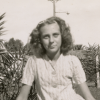 Beryl Long (1929 - )
Beryl Long (1929 - )
Beryl Long (nee MacLennan) was born in 1929 in Peach Street, North Perth. She was the youngest daughter of Leslie MacLennan of seven Peach Street, who bought the house from his parents in 1912 and lived there for 60 years with his wife Lillian and their five children.
|
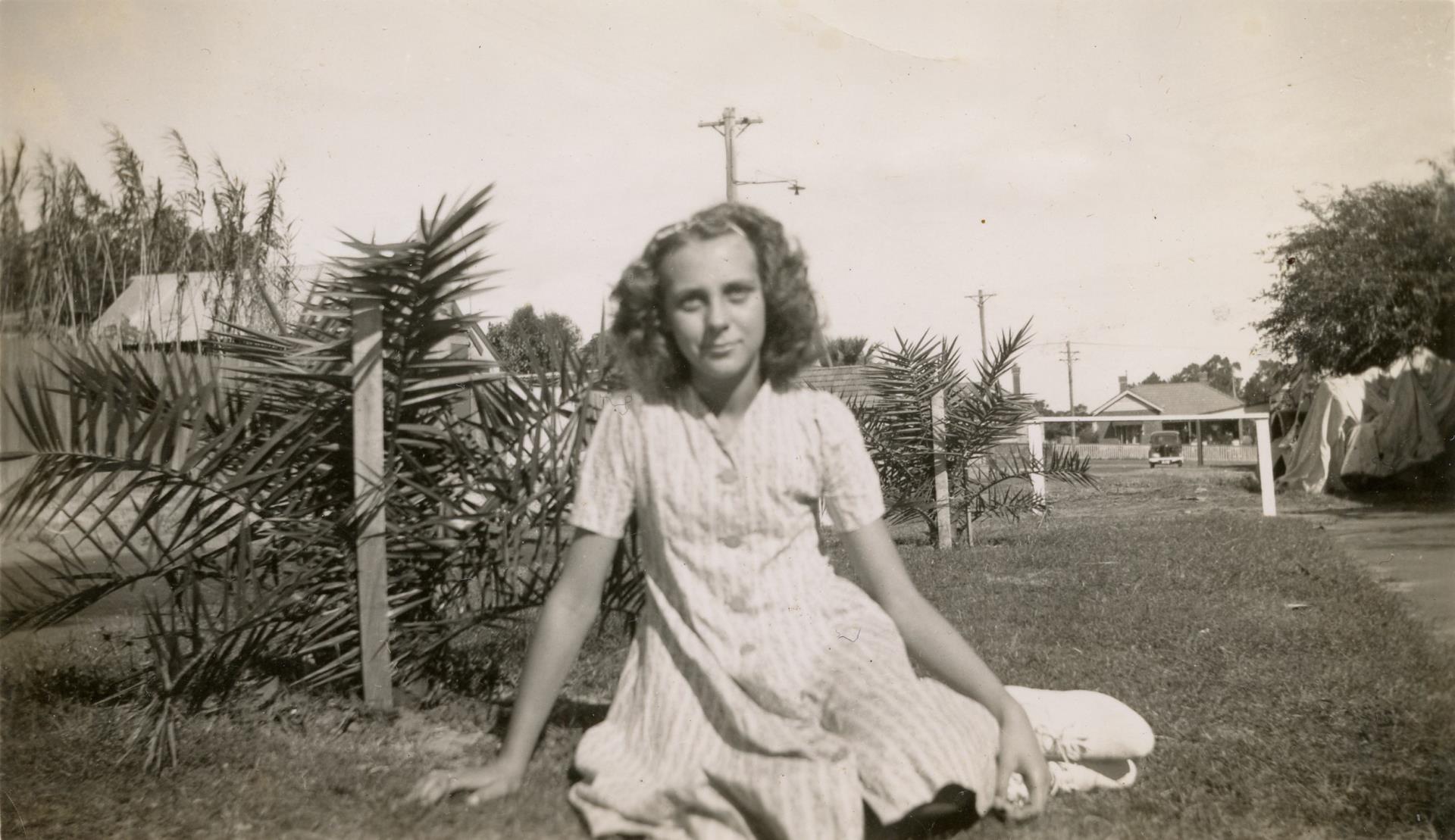
Beryl outside 7 Peach Street, North Perth, 1942.
|
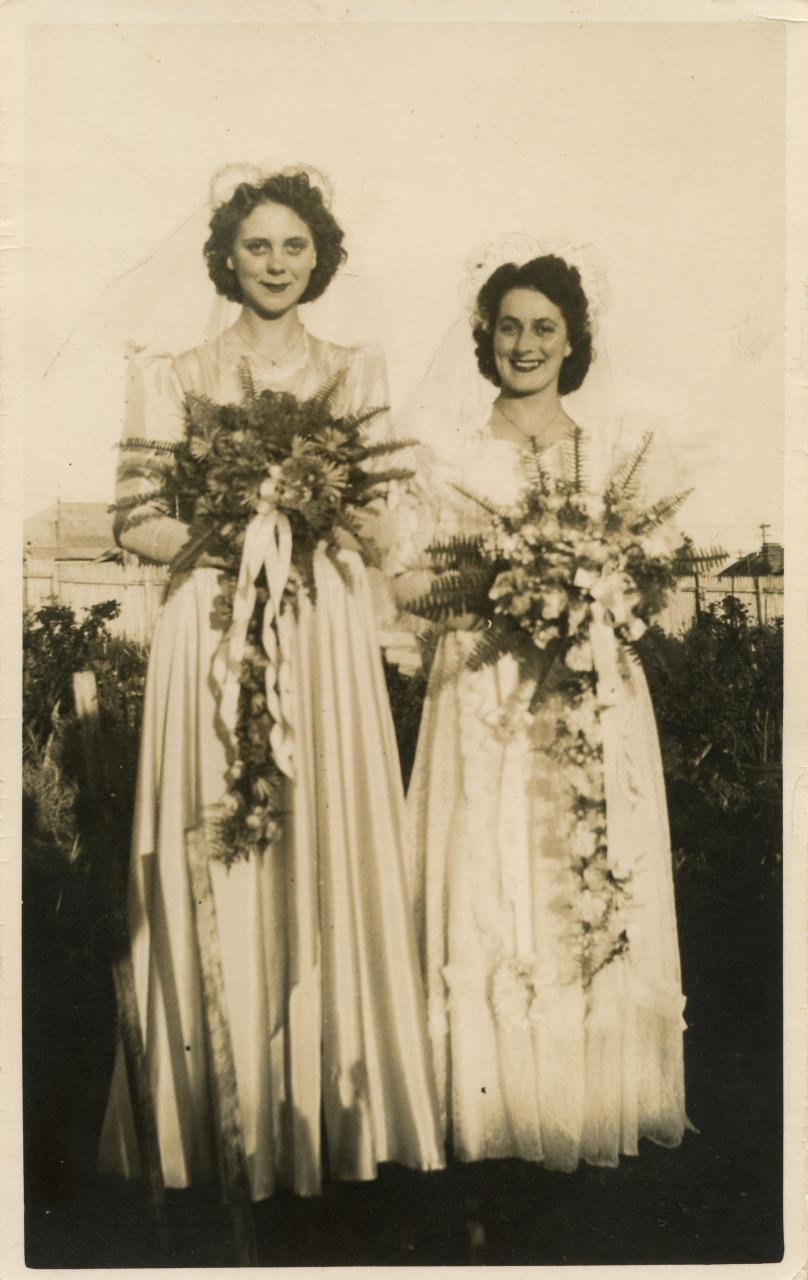
Beryl (left) with Sister Thelma, 1944.
|
In the early 1900s, Lillian MacLennan ran a successful dairy from the three adjacent vacant blocks in Peach Street. She milked the cows herself and delivered the milk with a horse and cart. In the late 1920s, Lillian used the land for floristry and as a market garden ensuring the family was self-sufficient during WWII.
"Mum had 27 cows and she milked them herself. A quarter to three every morning she got up and milked those cows and delivered it. She had a young man working for her and he lived in. His name was Dick Sibley. I suppose he helped Mum put the milk on the cart. It would be ladled out into the billies – there were no bottles then. She would ladle it out when she ran into the house and if some of the people were up and wanted to talk, well the horse would start going so she would say, ‘I’ll have to run’. She’d run and get on the cart…"
In the 1940s, Beryl was a musician whose band played at local weddings and birthday parties. Her income as a musician helped her save towards a deposit for a home. In 1951, she married George Long and they purchased the house next door from her parents at nine Peach Street. Their two children Alan and Sandra were the fourth generation of the family to live in Peach Street. The family moved out of the area in the 1980s and both houses were demolished. What remains are two large palm trees planted by the family outside 7 Peach Street in 1941.
|
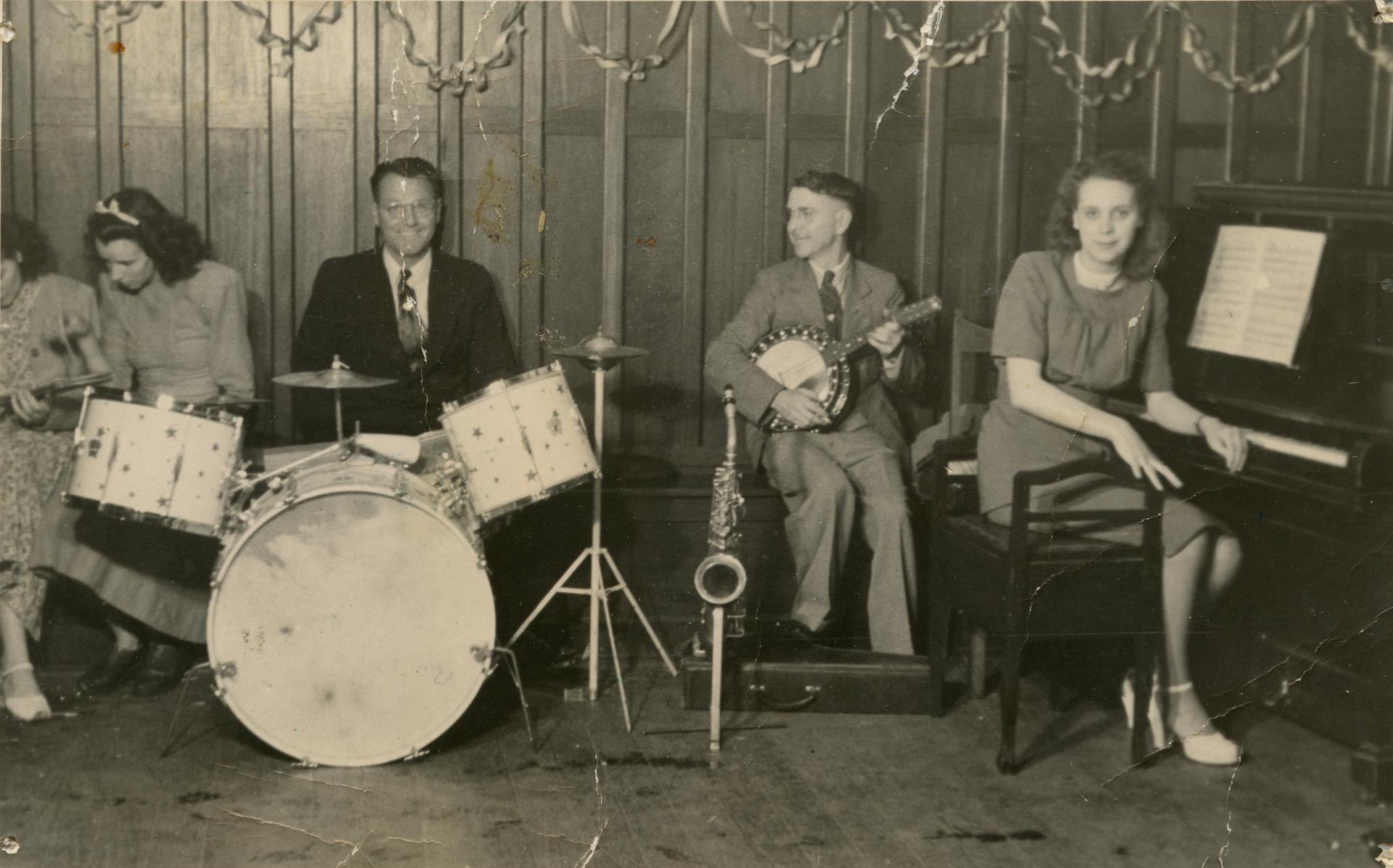
Beryl and her orchestra, Royal Park Bowling Club, 1948.
|
Read the full transcript of an interview with Beryl Long
Read Beryl’s story ‘That Funny Little Street: the story of Peach Street North Perth, 1897-1980’
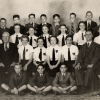 Geoffrey Bolton (1931 – 2015)
Geoffrey Bolton (1931 – 2015)
Geoffrey Bolton was born in 1931 and lived at Ethel Street and then Daphne Street, North Perth from 1939 till 1954. As a boy he attended North Perth State School before receiving a scholarship to Wesley College. He studied history at the University of Western Australia and Oxford University and went on to become a well-known Australian historian and author.
Despite a long and industrious academic career, Professor Bolton’s affection for North Perth never left him. In 1997, he published Daphne Street, a biography of an Australian community told through the stories of the North Perth street on which he grew up.
|

North Perth State School scholarship winners, 1943. Geoffrey Bolton is in the back row second from left.
|
In an oral history recorded with the City of Vincent in 2006, Professor Bolton recalled his North Perth childhood, sharing anecdotes about neighbourhood characters and places that made the neighbourhood distinct:
“It was a proper neighbourhood, you know, you got to know the grown-ups. You got to know which shopkeepers were crabby and which ones were a bit soft-hearted. It is tempting to indulge in nostalgia but it really was a time when kids could walk to and from school and feel safe about it. I remember one time when I was about seven or so, I went with some friends to the Zoo, got separated from them and there was no problem just to find your way back on the tram.”
Read the full transcript of an interview with Geoffrey Bolton